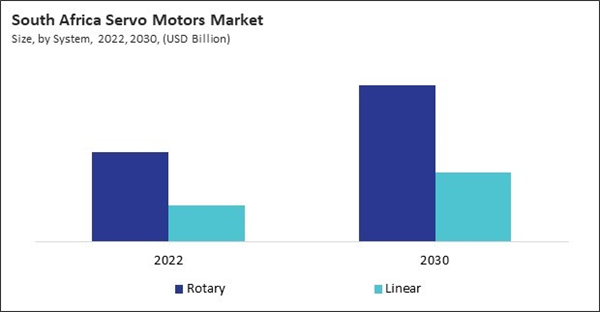The Brazil market dominated the LAMEA Servo Motors Market by Country in 2022, and would continue to be a dominant market till 2030; thereby, achieving a market value of $349 Million by 2030. The Argentina market is showcasing a CAGR of 7.9% during (2023 - 2030). Additionally, The UAE market would register a CAGR of 6.8% during (2023 - 2030).
A key trend is integrating Industry 4.0 principles and technologies, such as Internet of Things (IoT) connectivity, data analytics, and predictive maintenance, into servo motor systems. With real-time data and advanced analytics, manufacturers can optimize servo motor performance, anticipate maintenance needs, and minimize downtime, enhancing efficiency, reliability, and overall equipment effectiveness (OEE).
Furthermore, advancements in servo motor technology are enabling new applications and capabilities, such as collaborative robotics, additive manufacturing, and autonomous vehicles. These motors with enhanced precision, speed, and versatility empower industries to push the boundaries of automation and achieve unprecedented levels of productivity and innovation.
According to data from the Government of UAE, in 2020, the UAE approved a temporary license to test self-driving vehicles, a move that reflects the government's continuous efforts to adopt advanced technologies within all sectors. Testing autonomous vehicles is part of the UAE's strategy to become a global leader in attracting innovation and advanced technology applications. In addition, the Saudi government has implemented various policies and incentives to encourage automotive manufacturing and localization within the country. As per the data from the International Trade Administration, the automotive sector in the Middle East and North Africa (MENA) region is currently experiencing a 36% growth rate, with Saudi Arabia emerging as the primary industry in the area. In 2020, Saudi Arabia constituted 35% of the vehicles sold in the MENA region and nearly 52% of the vehicles sold in the Gulf Cooperation Council. In 2019, 556 thousand vehicles were sold in Saudi Arabia; in 2020, 436 thousand vehicles were sold. The projected sales figure by 2025 is 543,000 units. Hence, the rising adoption of self-driving cars and automotive sector growth in LAMEA will assist in the expansion of the regional market.
Based on System, the market is segmented into Rotary and Linear. Based on Type, the market is segmented into AC Servo Motor and DC Servo Motor. Based on Application, the market is segmented into Robotics, Machine Tools, Printing & Packaging Technologies, Electronic Devices and Others. Based on countries, the market is segmented into Brazil, Argentina, UAE, Saudi Arabia, South Africa, Nigeria, and Rest of LAMEA.
List of Key Companies Profiled
- Siemens AG
- ABB Group
- Yaskawa Electric Corporation
- Rockwell Automation, Inc.
- FANUC Corporation
- Mitsubishi Electric Corporation
- Parker Hannifin Corporation
- Schneider Electric SE
- Bosch Rexroth AG (Robert Bosch GmbH)
- Regal Rexnord Corporation
Market Report Segmentation
By System- Rotary
- Linear
- AC Servo Motor
- DC Servo Motor
- Robotics
- Machine Tools
- Printing & Packaging Technologies
- Electronic Devices
- Others
- Brazil
- Argentina
- UAE
- Saudi Arabia
- South Africa
- Nigeria
- Rest of LAMEA
Table of Contents
Companies Mentioned
- Siemens AG
- ABB Group
- Yaskawa Electric Corporation
- Rockwell Automation, Inc.
- FANUC Corporation
- Mitsubishi Electric Corporation
- Parker Hannifin Corporation
- Schneider Electric SE
- Bosch Rexroth AG (Robert Bosch GmbH)
- Regal Rexnord Corporation
Methodology

LOADING...









